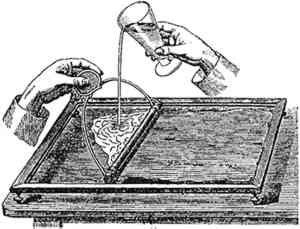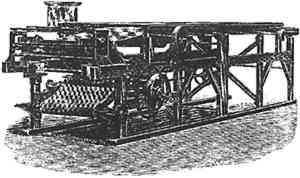DIFFERENCES IN IMAGE TONALITY PRODUCED BY DIFFERENT TONING PROTOCOLS FOR MATTE COLLODION PHOTOGRAPHSSYLVIE PENICHON
6 COATING OF THE PAPERBefore the industrial manufacture of collodiochloride paper, the operator himself had to prepare his paper (fig. 5). One could buy paper already coated with barium sulfate mixed with gelatin (baryta) at photographic suppliers. The method most frequently used by photographers to coat their paper was a technique directly inherited from the wet-plate process: the sheet of paper to be coated was secured to a rigid support and the light-sensitive emulsion was poured in the middle of it, as in the coating of wet-plate negatives. The paper was then tilted gently until its whole surface was coated, never allowing the emulsion to flow twice on the same portion of the paper. A thin film was preferred to a thick one because it gave a more even coating (Woodbury [1898] 1979, 113).
A. Kurtz introduced the first coating machine in 1889. Long rolls of baryta paper were pulled over a container of emulsion and brought quickly to a level position. Then the paper ran through a long tunnel box where a current of warm air blew (fig. 6). The paper was set and dry when it reached the end of the tunnel where it was cut up into sheets (Woodbury [1898] 1979, 114). The sheets were stored face to face with an interleaving of straw paper to regulate moisture (Wentzel 1960, 70). The paper had a shelf life of a few months if kept from light and excessive humidity.
In June 1893, an editor of Photographic Times visited the New York Aristotype Company in Bloomfield, New Jersey, and gave a brief account of the production of gelatin and collodio-chloride paper:
One advantage of producing collodioncoated emulsion paper over gelatin was that production could take place in a smaller room. The collodion paper dried very rapidly due to the fast evaporation of ether, and it did not need to be hung up in festoons like gelatin (Woodbury [1898] 1979, 113). Collodion emulsion was also easier to make than gelatin, because it could be done at room temperature, though it was rather more difficult to coat (Baker 1904). However, the tendency of the paper, when coated, to curl up at the sides was a problem, and special devices had to be installed on the coating machines to prevent the paper from curling up (Woodbury [1898] 1979, 113). Furthermore, guncotton could easily explode, and solvent fumes were very hazardous. |

